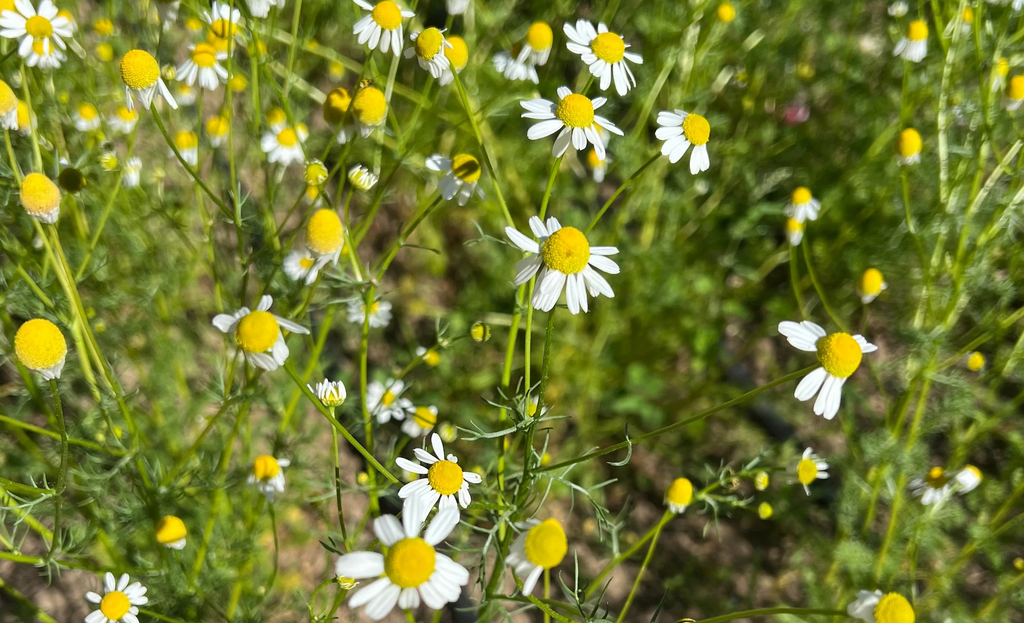Outside my window the fields are covered with snow. We are receiving a late winter snowfall here in Oregon. It is beautiful and dramatic but a bit gloomy. As a farmer, by the end of winter I am generally itching for those spring and summer days filled with plants exploding with growth, when the warm smells of earth move through the air. I really enjoy growing fragrant plants. What joy brushing past basil and dill brings! It is not just flowers that smell amazing. A lot of herbs have delightful scents but one of the most comforting is Chamomile.
OverviewChamomile on a warm summer day smells bright like apples! In fact the name is derived from two ancient Greek words that when combined mean ground apple (1). A member of the Asteraceae family, Chamomile resembles many plants in this family. It has bright green lacy foliage with adorable daisy-like flowers with bright yellow centers. When you are looking for Chamomile seeds to grow, make sure the latin name is Matricaria recutita. This variety is the one you probably know well, that ends up on most people's tea shelves. There is a look alike that grows as a weed where we live. I always know it is not the herbal ally I love because it has foliage that smells really bitter and harsh in comparison. It also has a more compact and dense nature.
Medicinal Remedies
Chamomile is likely an herb you know very well. It has been popular as an herbal remedy for many thousands of years (2). Unlike some herbs there are a lot of scientific articles out there that discuss the efficacy of its usage. Although there have not been many clinical trials conducted there is a fairly broad understanding of the chemical constituents. I generally consider it a go-to herb that is safe to have around. My mother used to give us Chamomile sometimes before bedtime if we were rowdy. The calming effect of it has been widely studied. It has also been documented as effective for anxiety and depression (3). One way I have used Chamomile with success is as an eye wash for conjunctivitis or other eye irritations. In the herbal text, Back to Eden, Chamomile is noted as an excellent wash for sore eyes (4). You make a simple tea, use organic Chamomile, steep the tea and let it cool and then use it to gently rinse the eye . According to the Women’s Health Encyclopedia of Natural Medicine, by Tori Hudson, Chamomile can have an antispasmodic effect on the uterus making it useful for alleviating menstrual cramps (5).
One of the main constituents in Chamomile is Chamaszulene which gives the extracted oil a blueish green hue (6). Chamazulene has been shown to be useful against gram positive and gram negative bacteria like E.Coli and staph infections (7). Chamomile is fairly safe to use but you do not want to use it all the time and there are contraindications for people with ragweed allergies (8).
How to Grow
Chamomile is so easy to grow and a must have in any home herb garden. It is an annual herb that can tolerate light Spring frosts. In warm climates it might last as a short lived perennial. Sow seeds indoors into flats filled with potting soil. Chamomile needs some light to germinate as the seeds are very small. Press the seeds into the potting soil and then cover lightly with vermiculite. The seeds germinate best at 65 degrees. You can direct seed Chamomile but I like to sow it in flats because of how small the seeds are. Plant the Chamomile seedlings out into the garden about 12-16 inches apart. If it is really hot where you live the plants can tolerate some afternoon shade.

How to Harvest
When you harvest Chamomile, the flowers are the most common part to use as they have the highest concentration of constituents. Harvest flowers in the morning. You can harvest your Chamomile plants in succession but the flowers get smaller and more sparse after each harvest. If you want to harvest a lot of flowers, plant two successions of Chamomile, 2-3 weeks apart. You can use the flowers fresh or dry. Use fresh flowers for essential oil extraction and dry flowers for things like tea. The flowers will dry quickly in a few days if left in a dark dry space. According to The Drunken Botanist , the constituents of Chamomile are stronger when they are dry (Stewart).
Happy Planting!
Taryn Hunter
Lead Seed Coordinator, Siskiyou Seeds
References:
- Milo. Wiktionary. (n.d.). Retrieved February 28, 2023, from https://en.wiktionary.org/wiki/milo Χαμαί in the New Testament. Greek New Testament - χαμαί. (n.d.). Retrieved February 28, 2023, from https://www.laparola.net/greco/parola.php?p=%CF%87%CE%B1%CE%BC%CE%B1%E1%BD%B7
- Singh O, Khanam Z, Misra N, Srivastava MK. Chamomile (Matricaria chamomilla L.): An overview. Pharmacogn Rev. 2011 Jan;5(9):82-95. doi: 10.4103/0973-7847.79103. PMID: 22096322; PMCID: PMC3210003.
- Balch, James F., and Phyllis A. Balch. Prescription for Nutritional Healing. 2nd ed., USA, Avery Publishing Group, 1997.
- Kloss, Jethro, and Promise K. Moffet. Back to Eden: The Classic Guide to Herbal Medicine, Natural Foods, and Home Remedies Since 1939. 1991.
- Hudson, Tori. Women’s Health Encylopedia of Natural Medicine: Althernative Therapies and Integrative Medicine. USA, Keats Publishing, 1999.
- Stewart, Amy. The Drunken Botanist. 2013.
- El Mihyaoui A, Esteves da Silva JCG, Charfi S, Candela Castillo ME, Lamarti A, Arnao MB. Chamomile (Matricaria chamomilla L.): A Review of Ethnomedicinal Use, Phytochemistry and Pharmacological Uses. Life (Basel). 2022 Mar 25;12(4):479. doi: 10.3390/life12040479. PMID: 35454969; PMCID: PMC9032859.
- Balch, James F., and Phyllis A. Balch. Prescription for Nutritional Healing. 2nd ed., USA, Avery Publishing Group, 1997.
Written by Taryn Hunter


Joshua
This is one of my favorite things to grow! Lots of good info here, thank you!